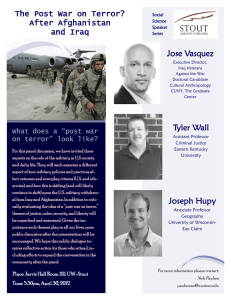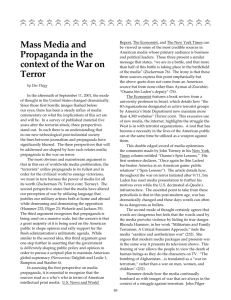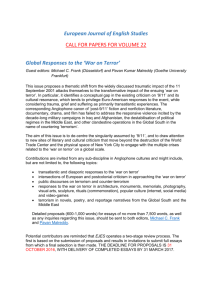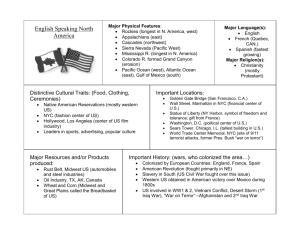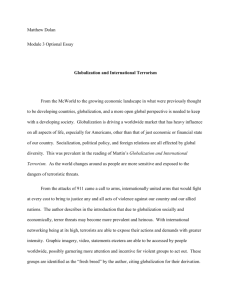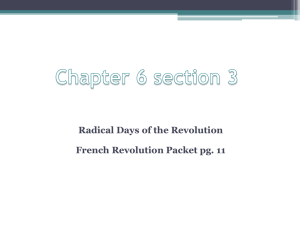The War on Terror and Aid Flows
advertisement
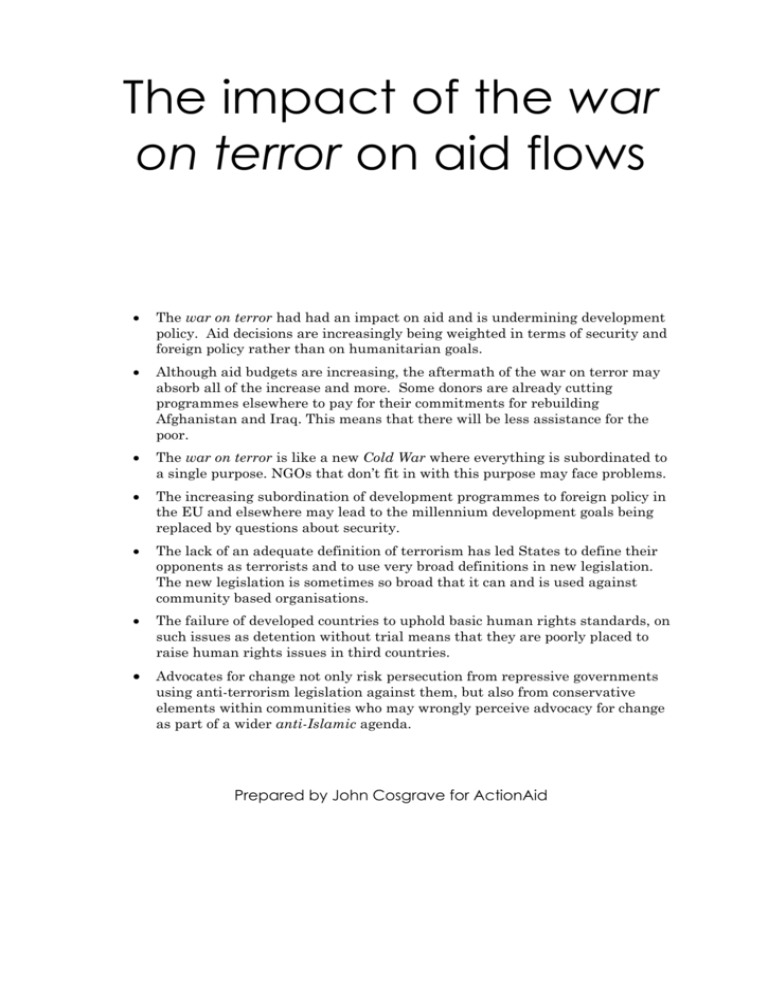
The impact of the war on terror on aid flows The war on terror had had an impact on aid and is undermining development policy. Aid decisions are increasingly being weighted in terms of security and foreign policy rather than on humanitarian goals. Although aid budgets are increasing, the aftermath of the war on terror may absorb all of the increase and more. Some donors are already cutting programmes elsewhere to pay for their commitments for rebuilding Afghanistan and Iraq. This means that there will be less assistance for the poor. The war on terror is like a new Cold War where everything is subordinated to a single purpose. NGOs that don’t fit in with this purpose may face problems. The increasing subordination of development programmes to foreign policy in the EU and elsewhere may lead to the millennium development goals being replaced by questions about security. The lack of an adequate definition of terrorism has led States to define their opponents as terrorists and to use very broad definitions in new legislation. The new legislation is sometimes so broad that it can and is used against community based organisations. The failure of developed countries to uphold basic human rights standards, on such issues as detention without trial means that they are poorly placed to raise human rights issues in third countries. Advocates for change not only risk persecution from repressive governments using anti-terrorism legislation against them, but also from conservative elements within communities who may wrongly perceive advocacy for change as part of a wider anti-Islamic agenda. Prepared by John Cosgrave for ActionAid The impact of the War on Terror on aid Page 2 Executive Summary Introduction The war on terror was launched by President Bush nine days after the September 11th attacks. Initially the war focused on the terrorist groups with global reach, but was then extended to include the Iraqi regime. In 2004 the war on terror will probably cost the US eight times as much as it spends on Overseas Development Aid. After a low point in the late 1990’s, aid flows were increasing prior to September 11th. That trend has continued with aid flows in 2002 reaching a record high. Aid is expected to again increase in 2003. This trend looks likely to continue in the near term with three further EU countries pledged to provide 0.7% of their Gross National Income (GNI) for aid. The September 11th attacks have brought renewed interest in development aid. US spending on Overseas Development Assistance is expected to rise in 2004, as it has in 2003. What is not clear is how much of this increase will be absorbed by Afghanistan, Iraq, and additional aid for countries assisting in the war against terror. In October 2003, the US pledged 20 billion dollars for reconstruction in Iraq. This amount is equal to one and a half times the USA’s annual development aid budget. Pledges by other donors were far smaller, but those like the UK, the European Commission, or Spain that have pledged an amount equivalent to 20% of their annual development budget for Iraq will have to dig deep. This will have a cost for existing development programmes as most countries have drawn contributions for Afghanistan and Iraq from existing budgets. Despite denials by donors, aid has often been used as a tool of foreign policy. The changing patterns of who gets aid can only be explained in terms of broader foreign policy. It has even been suggested that the reason for the decline of aid in the early 90’s was the ending of competition for clients during the Cold War. While development aid statistics are only available up to 2002, it is already clear that substantial sums flowed into Afghanistan and Pakistan. Pakistan is a very important player in the war on terror, and it became, in 2002 the largest recipient of ODA in the world. Afghanistan saw its aid receipts grow eightfold over the average for the second half of the 90’s. This new concentration in aid sees the poor losing out as the Millennium Development Goals are subordinated to a security first policy. In the 90’s aid was used to paper over the gaping holes of the lack of political action in both Bosnia and Rwanda. By the end of the 90’s, and the Kosovo crisis this had changed to aid being used to prop up political action and prevent unfavourable publicity. This policy was extended further in Afghanistan with pressure on Pakistan to keep its borders closed to prevent a politically embarrassing exodus, coupled with generous assistance for those who did cross. During the Cold War, both sides used aid to support their clients. The West used aid to combat communism. Countries that were seen as being under a communist threat got generous assistance, both development and military. After the Cold War the emphasis shifted to development criteria, culminating in the Millennium Error! Reference source not found. of Error! Reference source not found. ActionAid The impact of the War on Terror on aid Page 3 Development Goals with their targets for 2015. This targeting of poverty now appears to have been lost. After September 11th, the realisation that developed countries were at risk of major terrorist attacksA seems to have caused a change in approach in the West. Suddenly, the most important factor about an aid recipient was not the recipient’s level of need, but its importance and usefulness in the war on terror. The poor lose out doubly as it is the less poor who will be targeted by anti-terrorist development funding, as the very poor simply do not have the resource base to pose the threat of international terrorism. A further threat to the independence of aid has been the rush to draw aid into the foreign policy sphere. The European Union has possibly been the worst case of this, with the proposed European Constitution seeing not only development Aid but also Humanitarian assistance as being subordinated to the overall Common Foreign and Security Policy (CFSP). Within the European Union’s structures themselves the development decisions now fall under the review of Foreign Ministers rather than of Development Ministers. The United Nations quickly passed a binding resolution on terrorism, but it has no definition of what terrorism is. The draft UN definition of terrorism is so broad that it would appear to include ordinary criminal activity in its scope. This problem is repeated with national legislation. The polarisation of Muslim communities makes it harder and more risky for agencies trying to promote anything, such as women’s rights, that may be seen as challenging religious orthodoxy. Governments have taken advantage of the lack of firm definitions to define their opponents as terrorists, or to use vague definitions to allow opponents to be arrested under anti-terrorist legislation. Western countries, instead of upholding good human rights practices, have resorted to tactics like detention without trial. Worse, there appears to be at best, no objection to serious human rights abuses by repressive governments who are seen as allies in the war on terror. This places donor countries is a very poor position to argue for the respect of human rights in third countries. Agencies advocating for change are at risk of being prosecuted under anti-terrorist legislation, and Human Rights Watch has already documented cases of anti-terrorist laws being used to imprison activists. The attacks on the World Trade Centre imposed a cost in excess of $50Bn in addition to the death toll. The most expensive terrorist attack prior to this (in monetary terms) was the IRA bomb at Bishopsgate in the City of London in 1993 which is estimated to have had a $1Bn price tag, although it caused only one death. A Error! Reference source not found. of Error! Reference source not found. ActionAid
